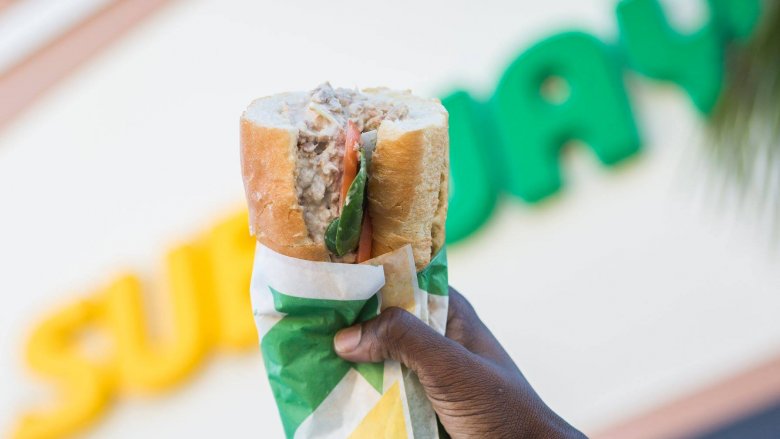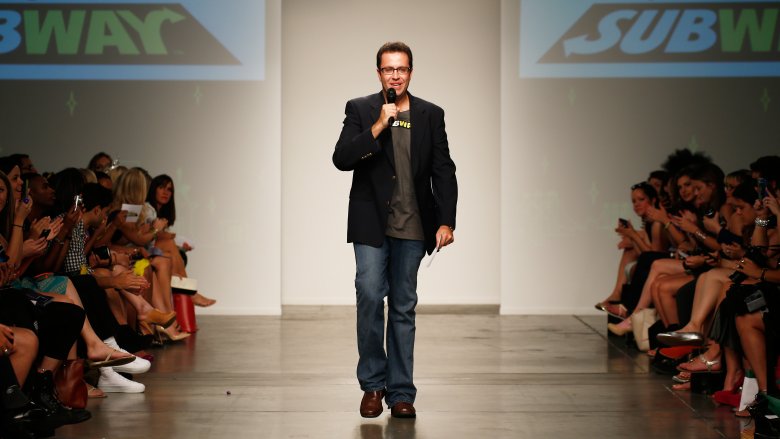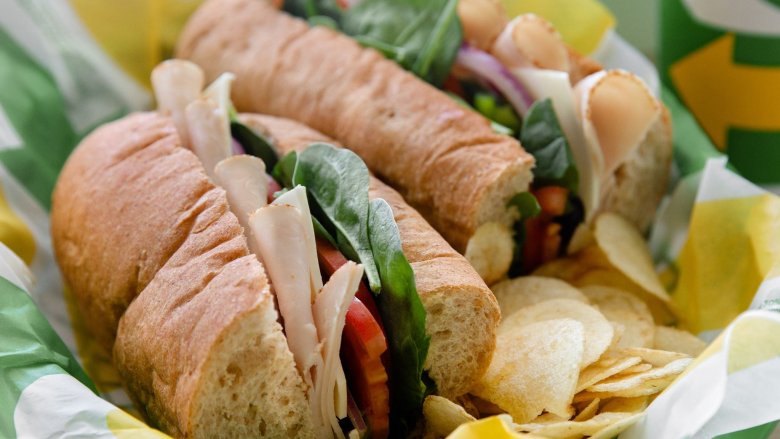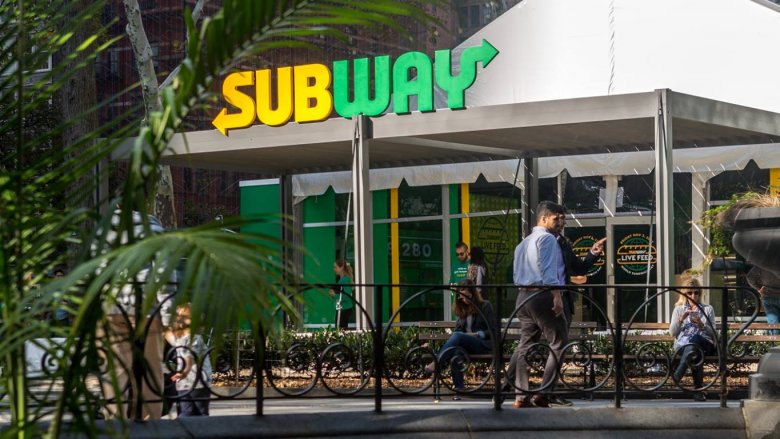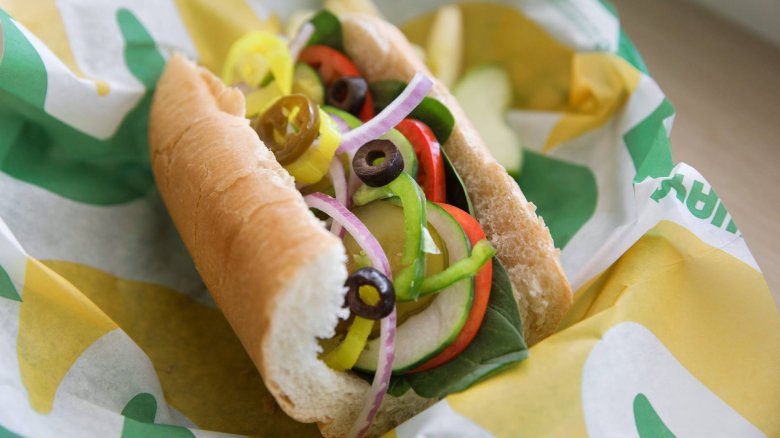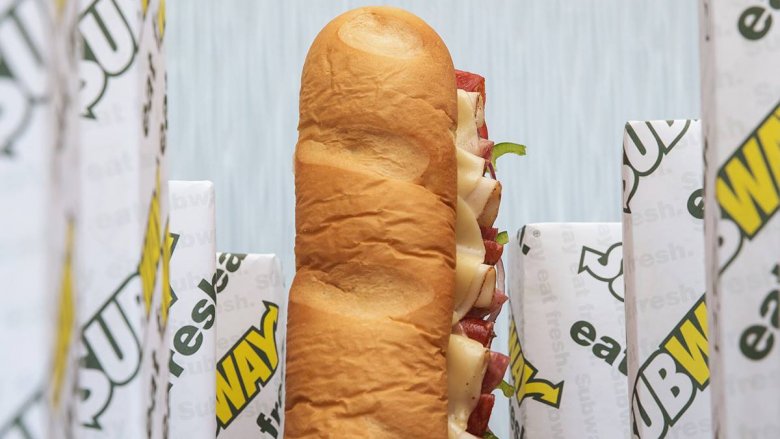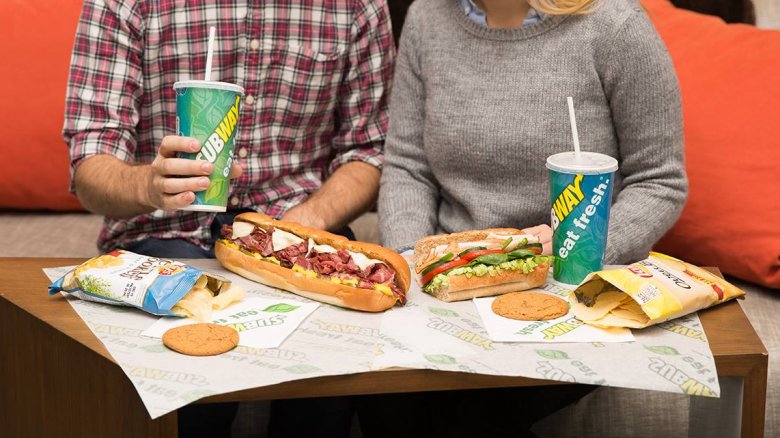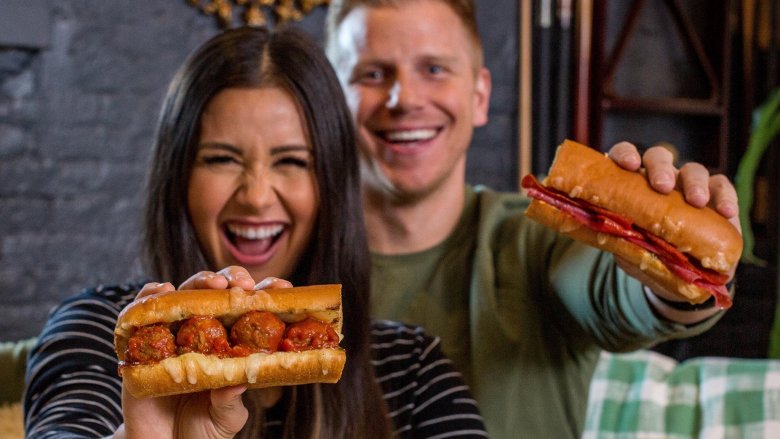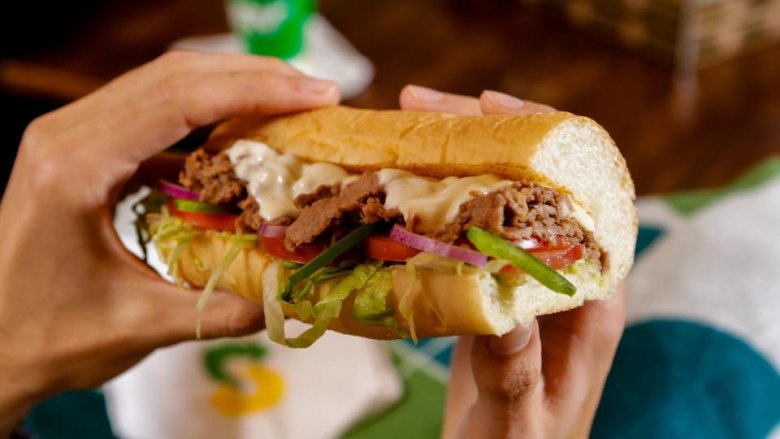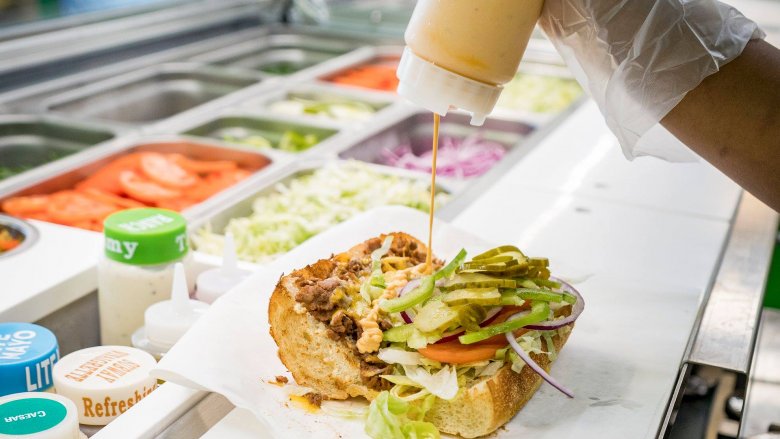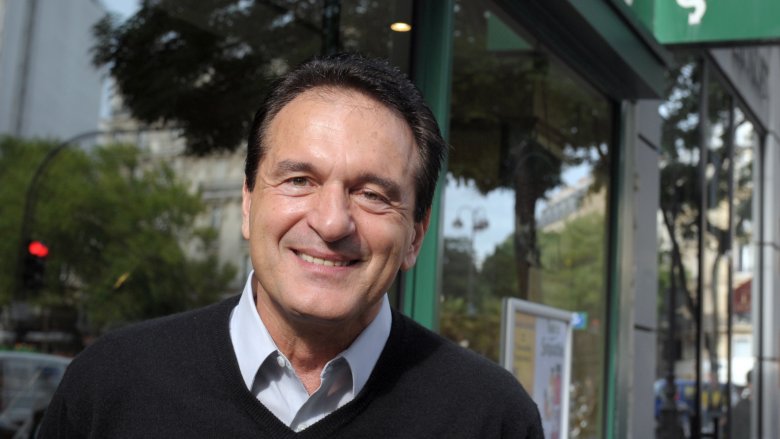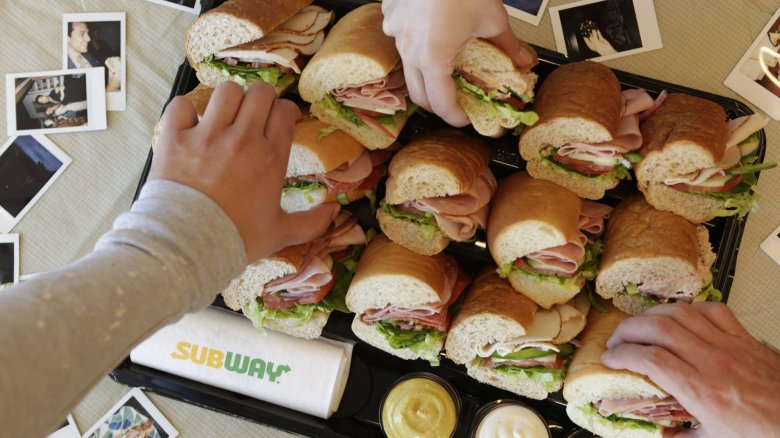Mistakes Subway Can Never Erase
Subway has been having some problems, and that's certainly no secret. Just look at it this way... If you were to ask a group of people what their favorite sandwich shops are, how shocked would you be if anyone answered, "Subway!"? And that sort of says it all right there.
Restaurant Business says that in 2018 alone, the company closed a whopping 1,110 locations. They still have a ton of stores, but the closures left them with fewer than they had back in 2011 — and that's the opposite of how growth works.
Subway corporate says they're focusing on "smart growth and restaurant optimization," which just sounds like a line, doesn't it? Because, here's the thing: Subway has made some horrible mistakes in recent years, and they're the sort of mistakes that people remember. They're the kind of large-scale, sweeping mistakes that make customers go elsewhere, and erasing the memory of those missteps is going to be next to impossible. What missteps? These.
Jared.
That's all that needs to be said, isn't it? Just: Jared.
Subway put a lot on the shoulders and image of Jared Fogle, who lost 245 pounds eating their sandwiches. At the time his ads were first broadcast, they had a huge impact... but we all know what happened next ... and he went to prison for it.
But hiring him wasn't the only mistake, because you could argue that Subway had no way of knowing just what his deepest, darkest fantasies actually were. Their mistakes just kept coming months after Fogle's arrest, when the sandwich chain finally posted this brief message on Facebook: "Jared Fogle's actions are inexcusable and do not represent our brand's values. We had already ended our relationship with Jared." Considering the very serious accusations against Fogle, this just doesn't seem like enough condemnation or outrage, does it?
When it came out that Fogle's charity — which was supposed to help obese children get healthy — didn't get most of the donations it was supposed to, Subway didn't try to make things right there, either. And that's the real mistake. There are times when "no comment" might be a completely acceptable response from a corporate entity, but this definitely wasn't it.
Falling behind the pack
Subway isn't the only sandwich shop in town, and over the years, they've only gotten more and more competition. Sure, when they first opened their doors, the idea that there was a sandwich artist making your lunch right in front of you was pretty neat. But according to Business Insider, they got so comfortable with those products, that set-up, and that image that they were content to rest on their laurels and forget they needed to keep up with the times.
In 2014, Subway saw a sales decline worse than what any other fast food chain saw. And that, analysts say, is partially because they were suddenly positioned alongside restaurants like Chipotle, who weren't just fresh, but who were ahead of them when it came to doing things like sourcing antibiotic-free meats. That wasn't even a thing when Subway started, but that doesn't matter. It only matters that they change to keep up with their competition and offer what people want — and they didn't. Not fast enough, at least, and that's the sort of nonchalant attitude toward customer desires and concerns that people remember.
Expanding too fast
In July 2015 — the same week as Fogle's downfall, in fact — Business Insider was reporting that not only did Subway have more locations than McDonald's, but they were hoping to take their 44,000 stores (and that's globally), and raise that number to 100,000. That's insane, and it turns out there's a reason McDonald's hasn't beaten them to it: Having that many locations can cripple a company, especially the way Subway was going about it. Darren Tristano of Technomic told The Washington Post, "More people have money to spend, and they're choosing to spend a little bit more on better concepts where they get a better product. ... Subway's strategy has only been to open more stores, and ultimately those stores just cannibalize each other."
Restaurant Business took a closer look at Subway's expansion plans, and when they spoke to franchisees, they learned something heartbreaking. Operators were essentially forced into opening multiple Subway locations almost on top of each other, because they were told that if they didn't do it, Subway would get someone else who would. The only way for them to try to protect what business they had was to open more and more locations and spread that business thinner and thinner... at the same time customers were starting to go elsewhere. Who thought that was a good idea?
Keeping the same-old
Let's talk about the menu. Sweet onion chicken teriyaki. Black forest ham. Italian BMT. Meatball marinara. Spicy Italian. Steak and cheese. Classic tuna. Veggie delight.
Now, are we talking about the menu in 1989, or the menu in 2019? See the problem?
Business Insider says that not recognizing the fact that tastes are evolving has been one of Subway's biggest problems. It's more than just tastes that are changing, too. It's the nation's perception of exactly what words like "fresh" and "healthy" mean. When Subway first debuted some of these sandwiches, they were healthier than the competition. But now, customers look at many of the sauces and lunch meats, and they're less impressive now that we know more about how bad these heavily processed meats are. It's all down to perspective, and it's odd that Subway has made the mistake of falling just so, so far behind what's cutting edge. Changing tastes is what they capitalized on in the first place, after all. Why stop there?
The nightmare of the $5 footlong
Subway kicked off their $5 footlong campaign in 2007, and if it seems like it's been around for much, much longer than that, it just goes to show how connected the idea is to the brand. People loved it, and that should have been a good thing. But it wasn't.
In 2016, Subway announced all those subs were going to be $6, and people weren't happy, says Grub Street — especially considering they were the same exact subs that had been $5 for so long. There was a lot going on behind the scenes of the decision, but the company's statement on Twitter was quite brief: "We launched the $5 footlong in 2007. Since then our costs have gone up greatly, but we try to balance that with promotions."
More drama followed two years later with the announcement that they were going to be bringing the promotion back. Sort of. According to Business Insider, the deal that came back in 2018 was a $4.99 footlong, and why? Who knows. But by September of that year, Subway backpedaled yet again and said they weren't going to be forcing franchisees to actually sell subs at that price point. It became a crapshoot as to whether or not customers could find the deal, and what better way to make the franchisees look like the bad guy and leave customers with no choice but to just give up trying? It left a bad taste in everyone's mouth.
That lawsuit
There's a few things that customers expect of a massive fast food chain: That they're going to get what they order, and that they can go into any location — whether it's in New York or California — and they'll be able to get a consistent product. When a lawsuit filed against Subway in 2013 hit headlines, customers realized the sandwich chain wasn't living up to either of those things.
You know the lawsuit — the one that claimed footlong subs were only 11 inches or less. According to Fox News, Subway originally settled the case with a promise that they were going to make an extra effort to produce a uniform product — something they should have been doing in the first place. But that wasn't the end of the case, and the Competitive Enterprise Institute got involved with an odd protest: They said the case benefited no one, except the attorneys that stood to make a shocking $520,000 for suing the sandwich chain. And that got the case thrown out.
There was more to it — Forbes reported that the majority of Subway sandwiches were, in fact, 12 inches long, and that the dough used in every roll was exactly the same, it just baked a bit differently. But no one remembers that part, do they? They only remember that Subway got sued for ripping off the customer, and that's a belief they probably should have worked harder to squash.
Bad PR
It's easy to argue that everything offends someone these days, but sometimes an ad campaign just misses the mark so badly, all that's left for a company to do is apologize and promise to learn from their mistakes. Subway's bad at that.
Take one of their ads that showed up in the fall of 2014, when Jezebel reported that the chain was trying to make "costume season" into an actual thing. What were they talking about? In a nutshell, Subway thought it was a brilliant idea to tell women they needed to visit the sandwich chain so they could stay (or get) thin, all so they could wear a next-to-nothing Halloween costume. Well then, at least we all know how they really feel.
And it's only gotten worse. In 2018, they ran an anti-McDonald's ad complete with the Golden Arches and a narrator that flatlines after saying "burger" a bunch of times. In poor taste? Absolutely, says Business Insider. Consumers deemed the ad incredibly annoying, and complained that "for anyone who has actually dealt with what a flatline means, [it's] highly disturbing." Subway's social media started apologizing, often in a painfully condescending way, while their chief advertising officer stood by the ads and claimed they were "encouraged by the responses."
Darn it, Subway, not all responses are good responses.
Missing that emotional connection
This one's best illustrated by an example, so we'll use McDonald's. Do you have any emotional connection to McDonald's, probably one that goes back to childhood? Do you think of playing in the PlayPlace with your friends, of going there for birthday parties, of hoping for a certain toy in a Happy Meal, of begging your parents to stop for McNuggets on the way home? Of course you do, and that's because McDonald's made a huge effort to connect with kids on an emotional level, so they would have adult customers. Forbes says it's one of the most important lessons anyone can learn from McD's.
Now, do you have the same kind of connection with Subway? Of course not.
According to AdAge, an emotional connection with customers is what Subway has always been missing. It wasn't until 2018 that Chief Advertising Officer Chris Carroll decided that maybe it was time to try to reach customers on that emotional level, and they were going to be doing it with their "Make It What You Want" campaign. It took them a long time to catch on to what chains like McDonald's and Burger King had always known, and it may be too little, too late.
Targeting the wrong market
When Bloomberg looked at exactly what was going wrong with Subway, they pointed out a fatal flaw in their marketing: They were targeting a market that wasn't actually there.
Look at it this way. Subway is affordable but their subs are "adequate" at best. When they started, that was fine. They were feeding people who didn't have a lot of cash, and giving them a halfway decent meal at a decent price. But now that there's more competition, a few things have happened...
There are people with more money to spend on lunch, and they're going to go somewhere with better options than Subway. Then, there are the people that still don't have a lot of cash to spend on lunch, but do you know what they're doing? They're spending less money to buy the ingredients and to make their sandwiches at home... because sandwiches aren't something that needs a ton of time, prep, or specialized equipment. And those sandwiches? They're far better than what Subway can offer, and the fact that the chain staked everything on a section of the market that's disappearing is a massive problem.
There aren't enough drive-thrus
In today's fast-paced world, the half hour or hour we have for lunch is crucial. It's not just for lunch, it's for errands, too. Grabbing some food is secondary, and that's where the drive-thru comes in. Why would you go and stand in line to order when you can swing through a drive-thru and quickly be on your way to get something important done?
This is where Subway needs to catch up, and fast.
As of 2017, only about 10 percent of their locations have drive-thrus. Though you'd think that ordering your custom sub from your car would prove difficult, customers apparently love the convenience, and thanks to touchscreen kiosks, they still have total control over whether or not their sandwich gets onions, pickles, or mayo. But with less than 2,500 stores offering the super-fast ordering option, is it enough? Probably not, because convenience is king, and once you have to park, get out of your car, and go inside, it's just not fast food anymore. As for the customers? They'll go elsewhere.
Success (or problems) start at the top
Subway was co-founded by Fred DeLuca, and regardless of the problems the chain has come to have, it's undeniable: He was a brilliant businessman. But here's the thing... He passed away in 2015 after fighting leukemia, and when he did, he handed the running of the company to his sister, Suzanne Greco. Greco became CEO at his death, but ownership of the company passed to DeLuca's widow, Elizabeth, and his original business partner, Peter Buck. According to Inc., all three had completely different ideas on how the company should be run.
Even when things were looking grim for DeLuca, and even as he went through chemotherapy and bone marrow transplants, he refused to put a plan in place for what would happen after his passing. No one wants to think about their mortality, but when you're sitting at the head of a massive company like Subway, it's crucial that there not only be plans in place for succession, but that those taking over should be on the same page.
And Subway's division was extreme. Elizabeth DeLuca wanted to fix Subway, Buck wanted to launch a whole new brand, and Greco was caught in the middle. It all happened at a critical juncture for Subway, and according to Business Insider, they ended up closing hundreds of stores in the following year and seeing a nearly 2 percent drop in sales.
Difficulties in rewarding loyalty
This isn't even Business 101, this is just common sense: Businesses should love loyal, repeat customers. That's a basic principle — so basic that it makes it even more shocking that Subway has had such a hard time in recognizing loyalty and showing appreciation.
Firstly, they had some major problems in rolling out a new customer loyalty program to replace their "Sub Club" loyalty card from the early 2000s, which was cancelled in 2005 due to rampant fraud. The Wise Marketer says it was well into 2017 that they were still announcing delays in their replacement loyalty program — you know, long after most other fast food places had their rewards programs firmly in place.
When it did hit, research done by YouGov BrandIndex (via QSR) found that while it was luring some new customers in the doors, longtime and once-loyal customers were less impressed and less likely to be making return trips. They weren't entirely sure exactly what was at work here, but do you know what companies should be doing? Letting their loyal customers know that their business is appreciated... otherwise, they're going to go somewhere that does appreciate them.
